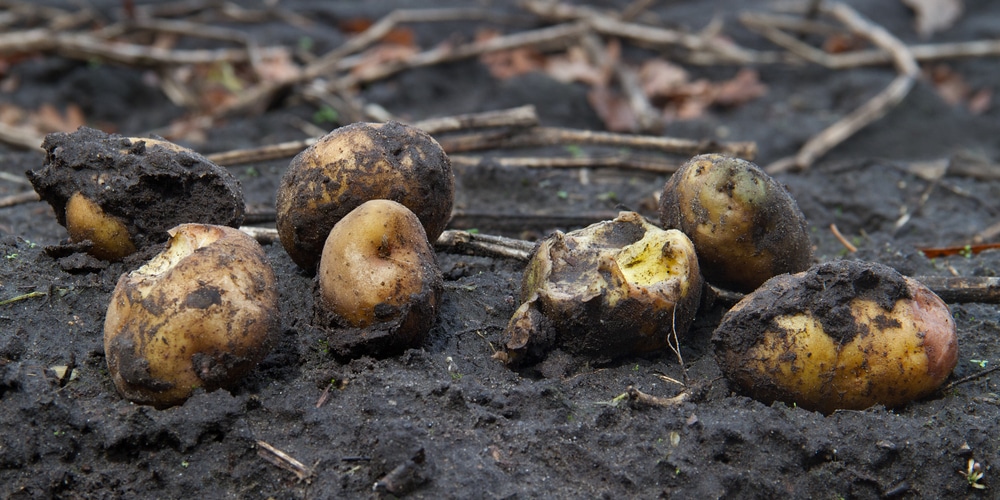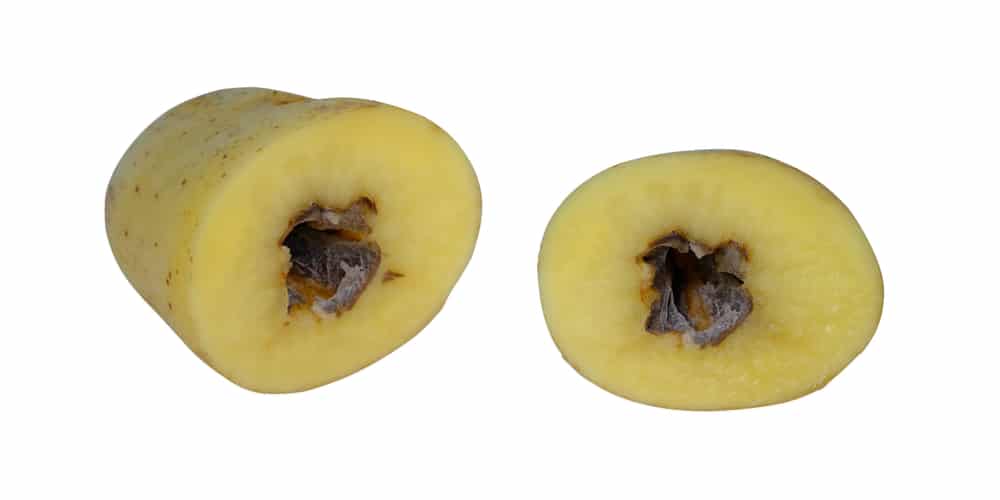Potatoes and other root vegetables are a great choice for your home garden. Their seeds produce large harvests, and they’re mostly easy to grow. This article will answer the question, ‘Why Do Potatoes Rot in the Ground?’ Let’s jump in.
Why Do Potatoes Rot in the Ground?

Tubers, taproots, corms, etc. are especially susceptible to rot. This makes sense – you _are_ putting them underground, after all, which exposes them to moisture and bacteria. So, if you’re considering starting a potato garden, it’s important to understand the main causes of underground rot and how you can avoid them.
TOO MUCH MOISTURE
First, growing potatoes don’t like to get wet. This is mainly because infectious bacteria thrive where there’s lots of moisture, leading to conditions such as soft rot or blackleg.
To avoid this, plant potato seeds in well-drained, loamy soil – clay soil will hold too much water.
Fertilizers with high levels of nitrogen should also be avoided since they can create a moist canopy that drips down onto your potatoes.
That being said, soil does need to be a bit wet – dryness can result in dry rot. Use the touch test to measure the wetness of your soil. If it feels wet to the touch, plant your potatoes elsewhere.
Potatoes need about 1-2 inches of water per week to grow so, if you’re getting very little rain, be sure to water accordingly.
PLANTING POTATOES WITHOUT RAIN PROTECTION
For a couple reasons, potatoes should not be exposed to _too much_ rain. The first is obvious: by protecting against rain you’ll prevent excessive moisture in the soil. The second has to do with a fungus called fomoznaya.
Fomoznaya causes phoma rot or button rot in potatoes, also known as potato gangrene. Droplets of this fungus ride on the wind and are more likely to spread to your potatoes when it rains.
It’s also very likely to cause secondary infections, meaning it could affect your entire garden!
You’ve probably read it’s best to plant your potatoes in spring. This is true as it will avoid frost. However, if you live in an area that usually has a very rainy spring, you’ll want to plan ahead.
You can protect your potatoes from the rain by creating hills in the fall – this is where you stack up soil around each spot where you’ll place seeds. Hilling also protects plants from the sun, which can turn them green.
SOFT ROT
Soft rot is a very common problem for tubers. If you’ve ever harvested potatoes with a wet, soft, tan-colored surface surrounded by black spots or rings, you’ll know all about this disease.
The most obvious way to avoid soft rot is by planting only disease-free seeds (“disease-free” means the seeds have been verified healthy by an independent testing agency). You also need to keep your soil from becoming too wet.
In addition, observe best agricultural practices such as crop rotation and make sure to clean your garden of debris.
NOT CURING CUT POTATOES
Some people like to get the most out of their harvest by cutting up seed potatoes into pieces and then planting each one. Each piece that has an “eye” can grow into its own plant.
However, if you do this you need to be sure to cure them before planting. This heals the cut potatoes and gives their skin time to harden, protecting them against underground rot.
To cure your potato pieces, store them in a humid spot with temperatures between 50 and 65 degrees Fahrenheit. Let them rest for 2-3 days before planting.
Another way gardeners do this is by placing the cut pieces in a paper grocery bag. Shut the top and then just let the bag sit at room temperature for 2-3 days. You’ll also want to shake the bag every day to keep pieces from getting stuck together.
Planting cut up seed potatoes without curing them is a very common way to get rot, so don’t skip this step!
Why Do Potatoes Rot in the Ground?: Final thoughts
Following all the above steps will help keep your potatoes from rotting underground. They’re definitely worth planting, they just need a bit of love and care first. Also, be sure to follow the proper steps to keep them from rotting after harvest. Best of luck!
